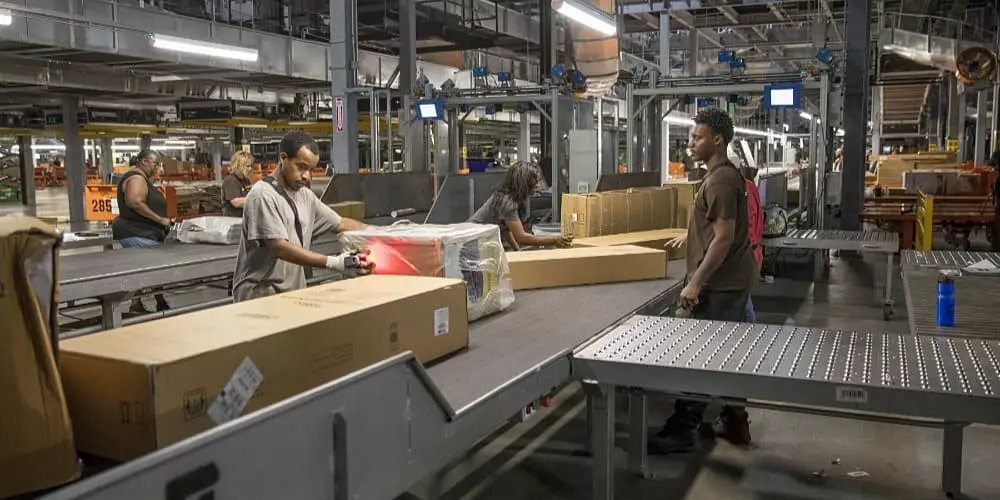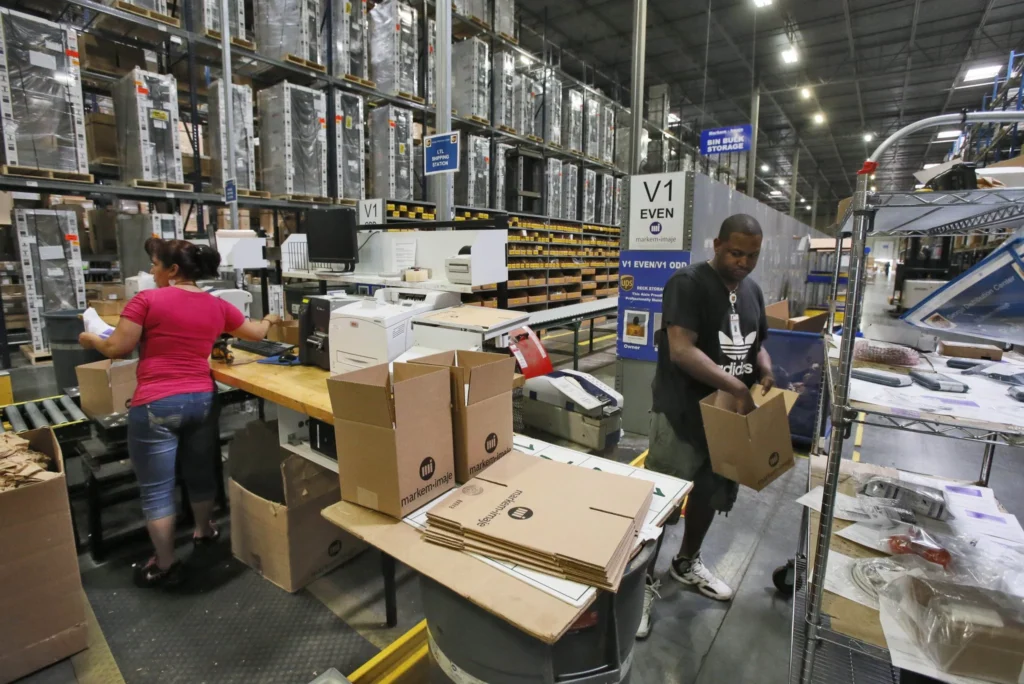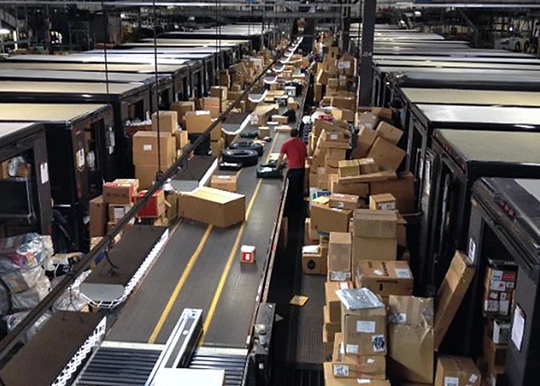What Does “Processing at UPS Facility” Mean? (Tracking Guide)
Understanding how processing at UPS Facility works, is very important to UPS customers because, in today’s fast-paced world of e-commerce and global shipping, efficient processing at UPS facilities plays a vital role in ensuring smooth operations and timely deliveries. As you read through, we will delve into the benefits that efficient processing brings, such as improved delivery speed, enhanced customer satisfaction, and cost-effectiveness.

Processing at UPS Facility
Processing at UPS facilities refers to the series of operations and tasks involved in handling and managing packages as they move through the facility.
It encompasses activities such as receiving, sorting, scanning, tracking, loading, and unloading packages in an efficient and organized manner.
READ ALSO!!!
- How to Send a Package UPS | A Guide to Effectively Use UPS
- UPS for Small Business | Understanding How UPS Store Works
- Understanding UPS Shipping Zone | An Easy Guide
- What is Ups Mychoice and How Does it Work?
Key Stages of Processing
1. Receiving and Sorting Packages
At UPS facilities, packages arrive from various sources, including drop-off locations, businesses, and online retailers.
During the receiving stage, packages are sorted based on their destination and characteristics such as size, weight, and type.
2. Scanning and Tracking
Each package undergoes a scanning process, where barcodes or tracking labels are read to record essential information. This allows UPS to track the package’s location and provide real-time updates to customers.
3. Loading and Unloading
Once packages have been sorted and scanned, they are loaded onto the appropriate vehicles for transportation.
Conversely, during unloading, packages are removed from incoming vehicles and organized for further processing or delivery.
What is the Importance of Accuracy and Speed in Processing?
Accuracy and speed are critical factors in UPS facility processing. Accurate scanning and tracking ensure that packages are correctly identified, minimizing the risk of misrouting or lost items.
Efficient processing enables timely sorting and loading, reducing delays and ensuring on-time deliveries.
The combination of accuracy and speed leads to customer satisfaction, as packages arrive as expected and within the promised timeframe.
Benefits of Efficient Processing

These are the benefits when the processing process is efficient:
1. Improved Delivery Speed
Efficient processing at UPS facilities directly contributes to faster delivery times. By streamlining the various processing stages, packages can be sorted, loaded, and dispatched more quickly.
This reduces transit times and enables UPS to meet tight delivery deadlines, especially for time-sensitive shipments.
2. Enhanced Customer Satisfaction
Timely and reliable delivery is a key driver of customer satisfaction. Efficient processing ensures that packages are handled promptly and accurately, leading to fewer delayed or lost shipments.
Customers can track their packages in real-time, gaining transparency and peace of mind. This positive experience fosters trust and loyalty towards UPS as a reliable shipping provider.
3. Reduction of Errors and Lost Packages
Accurate processing minimizes the risk of errors and lost packages. Each stage of processing, from scanning to sorting to loading, is carefully executed, ensuring that containers are correctly labeled, routed, and accounted for.
By reducing errors and improving package visibility, UPS can proactively address any potential issues and mitigate the chances of lost or misrouted shipments.
4. Cost-Effectiveness for UPS and Customers
Efficient processing contributes to cost savings for both UPS and its customers. UPS can handle a larger volume of packages by optimizing workflows and reducing processing times without requiring substantial additional resources.
This scalability improves operational efficiency and cost-effectiveness.
Additionally, customers benefit from competitive shipping rates due to the streamlined processes and economies of scale achieved through efficient processing.
By prioritizing efficiency in processing, UPS can provide faster, more reliable, and cost-effective shipping services, ultimately leading to higher customer satisfaction and loyalty.
In the next section, we will explore the technologies and systems that facilitate efficient processing at UPS facilities.
Technologies and Systems Used in UPS Facility Processing
1. Automated Sorting Machines
UPS facilities utilize advanced automated sorting machines to handle large volumes of packages quickly and accurately.
These machines use optical character recognition (OCR) technology and barcode scanning to identify packages and sort them based on destination.
Automated sorting machines significantly increase processing speed and efficiency while minimizing human error.
2. Package Tracking and Management Systems
UPS employs sophisticated package tracking and management systems that provide real-time visibility and monitoring throughout the processing journey.
These systems utilize barcodes, RFID (Radio Frequency Identification) tags, or QR codes to track packages at every stage, from arrival at the facility to final delivery.
Customers can access this tracking information online or through mobile applications, allowing them to stay informed about their shipments’ progress.
3. Robotics and Artificial Intelligence
Robotics and artificial intelligence (AI) play a growing role in UPS facility processing. Autonomous robots can be deployed to assist with tasks such as loading and unloading packages and optimizing the flow of operations.
AI algorithms are utilized for predictive analytics, enabling UPS to anticipate demand, optimize routing, and allocate resources efficiently.
4. Integration of Technology with Human Workers
While technology plays a crucial role, UPS recognizes the importance of human workers in the processing workflow.
Technology is integrated with human labor, allowing employees to work collaboratively with automated systems.
UPS invests in training its employees to operate effectively and leverage the benefits of the technologies used in facility processing.
The utilization of these technologies and systems in UPS facility processing enhances speed, accuracy, and overall operational efficiency.
In the following section, we will address the challenges that UPS facilities face and the solutions implemented to overcome them.
Challenges and Solutions in UPS Facility Processing

Processing isn’t a smooth process, here are the challenges encountered and the possible solutions:
1. Peak season Handling
Challenge: UPS facilities experience a significant surge in package volume during peak seasons, such as the holiday season. This increased workload puts strain on processing operations and may lead to delays or inefficiencies.
Solution: UPS employs proactive planning and resource allocation strategies to handle peak seasons effectively.
This includes hiring temporary staff, implementing extended work shifts, optimizing warehouse layouts, and leveraging advanced technologies to streamline processing during high-demand periods.
2. Managing a High Volume of Packages
Challenge: UPS facilities process an enormous number of packages daily, requiring efficient handling, sorting, and tracking to prevent bottlenecks and processing delays.
Solution: UPS invests in advanced automated sorting machines and conveyor systems to handle high package volumes.
These technologies and optimized workflows and barcode scanning enable rapid and accurate package sorting.
Additionally, UPS continuously monitors and adjusts its processing operations to ensure efficient flow and prevent congestion.
3. Addressing Potential Bottlenecks
Challenge: Various factors, such as incomplete or incorrect package information, unexpected delivery route changes, or congested transportation networks, can create bottlenecks in the processing workflow.
Solution: UPS implements comprehensive quality control measures to address bottlenecks.
This includes rigorous scanning and tracking protocols, proactive communication with customers regarding incomplete or inaccurate package information, and close collaboration with transportation partners to optimize delivery routes and mitigate congestion.
4. Continuous Improvement Strategies
Challenge: The evolving landscape of e-commerce and customer expectations requires UPS facilities to continually enhance their processing capabilities and adapt to new challenges.
Solution: UPS emphasizes a culture of continuous improvement. It actively seeks feedback from customers and employees to identify areas for optimization.
UPS invests in research and development to explore emerging technologies, such as machine learning and data analytics, to further improve processing efficiency, accuracy, and customer experience.
By addressing these challenges and implementing effective solutions, UPS ensures that its facility processing operations remain efficient, reliable, and capable of meeting the evolving demands of the shipping industry.
In the next section, we will discuss the crucial role of employees in UPS facility processing.
The Role of Employees in UPS Facility Processing
Let’s talk about the role that employees play in the processing process:
1. Training and Expertise Requirements
UPS recognizes the importance of well-trained employees in ensuring smooth and efficient facility processing.
Employees undergo comprehensive training programs to familiarize themselves with UPS’s systems, technologies, and operational procedures.
They receive instructions on package handling, scanning, sorting, and equipment operation to perform their roles effectively.
2. Importance of Teamwork and Communication
Effective teamwork and communication are vital for seamless processing operations.
UPS fosters a collaborative work environment, encouraging employees to communicate with each other and coordinate their efforts.
By working together, employees can efficiently handle packages, address issues in real time, and maintain a consistent flow of processing.
3. Ensuring Employee Well-Being and Safety
UPS places a high priority on the well-being and safety of its employees. The physical nature of facility processing can present challenges, such as heavy lifting and repetitive tasks.
UPS promotes ergonomics and provides appropriate equipment to minimize the risk of injuries. Regular safety training and protocols are implemented to ensure a safe work environment.
4. Adapting to Changing Demands
UPS employees play a crucial role in adapting to changing demands and maintaining operational efficiency.
They are trained to handle peak seasons, surges in package volumes, and unexpected situations.
Their adaptability and ability to make quick decisions ensure that processing operations continue smoothly, even in dynamic environments.
The dedication and expertise of UPS employees are instrumental in the success of facility processing.
Their training, teamwork, and commitment to safety contribute to efficient operations and customer satisfaction.
In the final section, we will explore some innovative advancements shaping the future of UPS facility processing.
READ ALSO!!!
- UPS Worldwide Saver: What is It?
- UPS Ship Food: Can You Ship Frozen Food With Ups?
- How to Ship a Bike UPS: A Guide to Shipping Bike
- What is UPS Surepost and How Does It Work?
Innovations in UPS Facility Processing
Before now, the process can be done manually but like every other thing, it has now evolved. Let’s take a look at the innovations involved with the UPS facility process:
1. Predictive Analytics for Optimized Processing
UPS utilizes predictive analytics to analyze historical data, customer demand patterns, and other relevant factors.
By leveraging this data, UPS can make informed decisions regarding resource allocation, routing optimization, and workload management.
Predictive analytics enables UPS to proactively address potential bottlenecks, improve processing efficiency, and enhance overall operational performance.
2. Autonomous Vehicles and Drones
UPS is exploring the use of autonomous vehicles and drones to revolutionize facility processing and last-mile delivery.
Autonomous vehicles can be utilized for efficient package transportation within the facility premises, minimizing manual labor and optimizing workflow.
Drones offer the potential for swift and cost-effective delivery in certain areas, especially for lightweight packages or locations with challenging terrain.
3. Sustainable Practices in Processing
UPS is committed to implementing sustainable practices in its facility processing operations.
This includes optimizing transportation routes to minimize fuel consumption and emissions, utilizing energy-efficient technologies and equipment, and exploring renewable energy sources.
By integrating sustainability into processing operations, UPS aims to reduce its environmental footprint while maintaining operational efficiency.
4. Robotics and Automation
Robotics and automation continue to play a significant role in UPS facility processing. Advanced robotics systems are employed for tasks such as loading and unloading packages, reducing manual labor and increasing efficiency.
UPS also utilizes automation for data entry, scanning, and tracking, ensuring accuracy and streamlining processes.
These innovative advancements are shaping the future of UPS facility processing, driving efficiency, sustainability, and customer satisfaction.
By embracing emerging technologies and incorporating sustainable practices, UPS aims to stay at the forefront of the industry and deliver exceptional service to its customers.
Conclusion
efficient processing at UPS facilities is essential for ensuring timely deliveries, customer satisfaction, and cost-effectiveness.
By leveraging advanced technologies, fostering a collaborative work environment, and embracing sustainability, UPS continues to drive innovation and maintain its position as a leader in the logistics industry.
